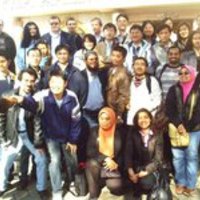Books by Nissreen El-Saber

Software rearchitecting is the process of obtaining a documented architecture for an existing und... more Software rearchitecting is the process of obtaining a documented architecture for an existing undocumented system. There are many software rearchitecting frameworks which are based upon different concepts and context-related issues for a specific application or programming language, such as Rigi, Ciao, SPOOL, and Symphony. These rearchitecting frameworks were compared and analyzed, in this work, using generic architecture characteristics. Based on this comparison, a new model for rearchitecting frameworks is proposed. As an implementation, a new framework was built according to the model standards. This is ?Software Rearchitecting Action Framework' (SRAF). Then an automated Java tool, Rearchitecting Tool Support (RTS), is designed to validate the framework. In this book we propose an discuss the SRAF and RTS which we argue it will assist the architect in deciding which kind of architectural style is the best to describe the system, and hence, to enhance it. Hence, they provide good methodology for obtaining a suitable level of documentation of the undocumented open source object-oriented software.
Papers by Nissreen El-Saber
Neutrosophic Systems with Applications, Sep 6, 2023
Neutrosophic and Information Fusion, 2023

American Journal of Business and Operations Research
Inventory management (InvM) is a critical aspect of supply chain management (SCM) and optimizing ... more Inventory management (InvM) is a critical aspect of supply chain management (SCM) and optimizing inventory levels can lead to significant cost savings and improved customer satisfaction. Hence, business organizations have recently worked to increase the value of their operations by utilizing modern and digital technologies as industry 4.0 (Ind 4.0). In the era of Ind 4.0, the technologies as Internet of Every Things (IoET), AI, BDA…etc. Recognizing the significance of InvM in a supply chain (SC), motivated us to volunteer technologies of Ind 4.0 as machine learning (ML) techniques to boosting Decision Making (DM) process to optimize InvM. Subsequently, this study is constructed for providing an intelligent Decision Support ML framework for automating the process of optimizing inventory management. Our constructed framework ensembles powerful ML prediction algorithms for inventory management, such as Artificial Neural Networks (ANNs), Random Forest (RF), and Support Vector Machine (S...

Sustainability
Most studies in recent decades focused on transforming linear economics into circular through rec... more Most studies in recent decades focused on transforming linear economics into circular through recovering and remanufacturing the products. Circular Economies (CE) aim to minimize the usage of resources by utilizing the waste in production as new or raw materials. Interconnectivity between parties in the industrial system provides decision-makers with rich information and anticipation of failure. Industry 4.0 technologies (I4.0) allow for handling such issues, protecting the environment by utilizing resources efficiently, and restructuring the industry to be smarter as well. This paper contributes to achieving cleaner production (CP), CE, and social for manufacturers through the linkage between 6R methodology with new technologies of I4.0 such as Blockchain technology (BCT) and big data analytical technology (BDA). In this paper, the authors proposed a Multi-criteria decision-making (MCDM) decision framework based on the best-worst method (BWM), Decision-Making trial and evaluation l...
Proceedings of the 2014 Workshop on Behaviour Modelling-Foundations and Applications - BM-FA '14, 2014
OMG's Business Process Model and Notation (BPMN) standard provides an informal specification ... more OMG's Business Process Model and Notation (BPMN) standard provides an informal specification of a technology independent modelling language for designing business processes. However, BPMN models may include structural issues that hinder their design. In this paper, we propose a formal characterization and semantics specification of well-formed BPMN processes in rewriting logic using Maude with a focus on data-based decision gateways and data objects semantics. Our formal specification adheres to the BPMN standards, verified with respect to the classical workflow soundness definition, and automatically verified using the verification toolkit that Maude includes.

Sustainability, 2021
The development of sustainable green buildings (GBs) is a major contribution to the preservation ... more The development of sustainable green buildings (GBs) is a major contribution to the preservation of the environment. Sustainable thinking in GB construction is not a supplementary element, but rather necessary to achieve the building’s functional, economic, and environmental efficiency in order to preserve resources and meet current and future needs. In particular, developing countries can apply the idea of sustainability in GBs by following international policies and standards, combined with their local characteristics, to construct GBs that are aligned with the environment and are in line with the available local capabilities and resources. The paper focuses on the dimensions and indicators of sustainable design for GBs in developing countries to achieve the positive dimensions of building sustainability, such as preserving energy and natural resources, water management, adaptation to the surrounding environment, and respecting the needs of its users. We assess and prioritize the ...

Software rearchitecting is the process of obtaining a documented architecture for an existing sys... more Software rearchitecting is the process of obtaining a documented architecture for an existing system. There are many software rearchitecting frameworks which are based upon different concepts and context-related issues for a specific application or programming language, such as Rigi, Ciao, SPOOL, and Symphony, and Software Rearchitecting Action Framework (SRAF). Most of the frameworks focus on the reverse engineering process of source code. They neglect the role of stakeholders in enhancing and developing their systems. This paper presents a systematic analysis and comparative study for rearchitecting frameworks using generic architecture characteristics or elements. Based on the major requirements that should be available in the rearchitecting frameworks, the comparative study proceeds. An efficient model is proposed based on the trends that resulted from the comparative analysis. It considers the evaluation criteria of the compared frameworks. Conclusions and remarks are highlighted.
Proceedings of the 3rd Africa and Middle East Conference on Software Engineering, 2017
Interoperability and enormous data processing remain significant challenges for Internet of Thing... more Interoperability and enormous data processing remain significant challenges for Internet of Things' Systems. High heterogeneity in protocols, Vendors, data formats and worldwide acceptable standards' scarcity increase Interoperability Challenge. Depending on a centralized cloud server for data processing increased data latency and turn brokered systems into a bottleneck. In this paper, we proposed generic IoT applied architecture based on scalable distributed computing model from sensor node passing by IoT gateway to Cloud Server to minimize data latency and mitigate data processing burden on a centralized server. Our architecture is also based on an interoperable gateway using semantic web technologies to provide Interoperability among heterogeneous IoT devices.

Software rearchitecting is the process of obtaining a documented architecture for an existing und... more Software rearchitecting is the process of obtaining a documented architecture for an existing undocumented system. There are many software rearchitecting frameworks which are based upon different concepts and context-related issues for a specific application or programming language, such as Rigi, Ciao, SPOOL, and Symphony. These rearchitecting frameworks were compared and analyzed, in this work, using generic architecture characteristics. Based on this comparison, a new model for rearchitecting frameworks is proposed. As an implementation, a new framework was built according to the model standards. This is ‘Software Rearchitecting Action Framework' (SRAF). Then an automated Java tool, Rearchitecting Tool Support (RTS), is designed to validate the framework. In this book we propose an discuss the SRAF and RTS which we argue it will assist the architect in deciding which kind of architectural style is the best to describe the system, and hence, to enhance it. Hence, they provide g...

IEEE Access
Autonomous/self-driving vehicles have gained significant attention these days, as one of the inte... more Autonomous/self-driving vehicles have gained significant attention these days, as one of the intelligent transportation systems. However, those vehicles have risks related to their physical implementation and security against cyber threats. Therefore, this study proposes a new security-by-design model for estimating the uncertainty of autonomous vehicles and measuring cyber risks; thus it assists decision-makers in addressing the risks of the physical design and their attack surfaces. The proposed model is developed using neutrosophic sets that efficiently tackle multi-criteria decision-making (MCDM) problems with extensive conflicting criteria and alternatives. The proposed model integrates MCDM, Analytic Hierarchy Process (AHP), Multi-Attributive Border Approximation Area Comparison (MABAC), and Preference Ranking Organization Method for Enrichment Evaluations II (PROMETHEE II), along with single-valued neutrosophic sets (SVNSs). An illustrative case considering ten risks in self-driving vehicles is used to validate the feasibility of the proposed model. Compared to the state-of-the-art methods, the proposed model is considered consistent and reliable to deal with and represent uncertainty and incomplete risk information using neutrosophic sets.
Reverse engineering of program code is the process of constructing a higher level of abstraction ... more Reverse engineering of program code is the process of constructing a higher level of abstraction of an implementation in order to facilitate the understanding of a software system. Reverse architecting code has been advocated to identify the current software architecture of existing software; to assess its quality, and to determine improvement areas. There are several reverse engineering tools built upon several methodologies for analyzing object oriented source code. These approaches are addressed and evaluated to focus on their capabilities with the aim of applying selection approaches to JAVA source code. A framework for software rearchitecting and rearchitecting tool support is proposed. Recommendations and remarks have been highlighted.

International Journal of Software Engineering, Jan 2009
Software rearchitecting is the process of obtaining a documented architecturefor an existing syst... more Software rearchitecting is the process of obtaining a documented architecturefor an existing system. There are many software rearchitecting frameworkswhich are based upon different concepts and context-related issues for aspecific application or programming language, such as Rigi, Ciao, SPOOL, andSymphony, and Software Rearchitecting Action Framework (SRAF). Most of theframeworks focus on the reverse engineering process of source code. Theyneglect the role of stakeholders in enhancing and developing their systems. Thispaper presents a systematic analysis and comparative study for rearchitectingframeworks using generic architecture characteristics or elements. Based on themajor requirements that should be available in the rearchitecting frameworks,the comparative study proceeds. An efficient model is proposed based on thetrends that resulted from the comparative analysis. It considers the evaluationcriteria of the compared frameworks. Conclusions and remarks are highlighted.
37th Internationan Conference on Computers and Industrial Engineering - CIE37, Oct 2007
ABSTRACT: Reverse engineering of program code is the process of constructing a higher level of ab... more ABSTRACT: Reverse engineering of program code is the process of constructing a higher level of abstraction of an implementation in order to facilitate the understanding of a software system. Reverse architecting code has been advocated to identify the current software architecture of existing software; to assess its quality, and to determine improvement areas. There are several reverse engineering tools built upon several methodologies for analyzing object oriented source code. These approaches are addressed and evaluated to focus on their capabilities with the aim of applying selection approaches to JAVA source code. A framework for software rearchitecting and rearchitecting tool support is proposed. Recommendations and remarks have been highlighted.











Uploads
Books by Nissreen El-Saber
Papers by Nissreen El-Saber